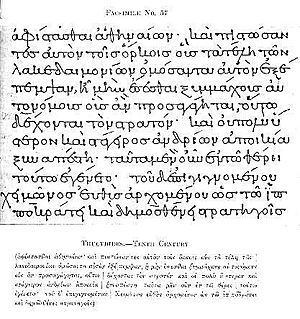History of the Peloponnesian War facts for kids
The History of the Peloponnesian War is a famous book. It tells the story of the Peloponnesian War in Ancient Greece. Thucydides, an Athenian general, wrote this book. He was part of the war himself.
The war was a big fight between two groups. One was the Peloponnesian League, led by Sparta. The other was the Athenian League, led by Athens. This long war lasted for over 20 years. Many historians today see Thucydides' History as one of the first truly scholarly history books ever written.
Contents
How Thucydides Wrote History
Thucydides' History changed how people wrote history. Many of his ideas are still used today. He had special ways of telling the story of the war.
Organizing Events by Year
One new idea Thucydides had was to use a strict timeline. He wrote down events year by year. Each year had a summer season for fighting and a quieter winter season. This meant that events happening over several years might be split up in the book. This was different from Herodotus' earlier work, The Histories, which jumped around more.
Including Important Speeches
Another special part of the book is the many speeches. Thucydides wrote down what important people said during the war. He heard some of these speeches himself. For others, he wrote what he thought was said, based on what happened.
Trying to Be Fair and Neutral
Thucydides wanted his writings "to last for ever." So, he tried to be as fair as possible. This was hard for him because he was an Athenian general. But he worked hard to show both sides of the story.
Focusing on Human Choices
In Thucydides' book, the gods do not play an active role. This is very different from Herodotus, who often talked about the gods. Instead, Thucydides believed that history happens because of the choices and actions of people.
The History mainly focuses on the military side of the Peloponnesian War. But it also shows other important ideas. For example, it shows the bad effects war can have on people. The book does not talk much about Greek art or architecture. Instead, it often discusses how military tools and methods developed.

Thucydides explained why the Peloponnesian War started. He said it was because Athens grew very powerful. This made Sparta feel worried and scared. The Spartans were a more traditional power and did not want to expand as much.
What the Book Covers
Thucydides' History is divided into eight books. Each book covers different parts of the war.
- Book 1
- Book 2 (431-428 BCE)
- This book describes the start of the war. It talks about the first invasion of Attica, the land around Athens. It also includes Pericles' Funeral Oration, a famous speech. The book also covers the terrible plague of Athens and naval battles.
- Book 3 (428-425 BCE)
- Book 4 (425-423 BCE)
- This book describes how the Athenians took over Pylos and captured Spartan soldiers on Sphacteria. It talks about peace talks that failed. It also covers battles in Sicily and the important Battle of Delium.
- Book 5 (422-415 BCE)
- This book tells about the deaths of important leaders like Cleon and Brasidas. It describes the Peace of Nicias, which was supposed to end the war but did not last. It also includes the famous Melian Dialogue and the sad fate of Melos.
- Book 6 (415-414 BCE)
- This book focuses on the start of the Sicilian Expedition. This was a huge Athenian attack on Syracuse in Sicily. It also talks about the scandal of the Hermae and the disgrace of Alcibiades.
- Book 7 (414-413 BCE)
- This book describes the arrival of Spartan help for Syracuse. It tells about the building of the fort at Decelea. It also covers the defeats of the Athenian army and navy in Sicily. The book ends with the complete destruction of the Athenian army there.
- Book 8 (413-411 BCE)
- This book talks about the revolt of Ionia and the involvement of Persia in the war. It describes political changes in Athens, including a coup d'état (when a small group takes power). It also covers naval battles like the Battle of Cynossema.
Images for kids
See also
 In Spanish: Historia de la guerra del Peloponeso para niños
In Spanish: Historia de la guerra del Peloponeso para niños





